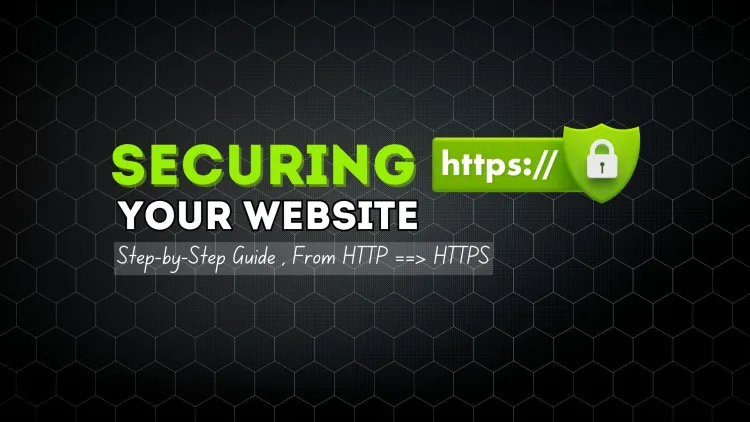How to Secure Your Website | A Step-by-Step Guide to Moving from HTTP to HTTPS
Switching from HTTP to HTTPS is essential for improving your website’s security, SEO ranking, and user trust. HTTPS encrypts the data exchanged between the server and the user’s browser, protecting sensitive information from potential threats. To make the switch, you need an SSL certificate, which comes in three types: DV (Domain Validation), OV (Organization Validation), and EV (Extended Validation). Once the certificate is installed, update internal links, set up 301 redirects to ensure proper redirection to secure pages, and submit an updated sitemap to search engines. The transition to HTTPS helps improve SEO, boosts user trust, and complies with data protection regulations, making it a necessary step for any modern website.

In today’s digital age, securing your website has become more crucial than ever. With cyber threats and hackers always on the lookout for vulnerabilities, it's essential to ensure your website is safe for both your users and your business. One of the best ways to secure your site is by switching from HTTP (Hypertext Transfer Protocol) to HTTPS (Hypertext Transfer Protocol Secure).
Not only does HTTPS provide better security, but it also helps improve your website’s credibility, SEO ranking, and user trust. In this blog, we’ll explain what HTTPS is, why it’s important, and guide you through the steps to switch from HTTP to HTTPS in a simple and easy-to-understand manner.
What is HTTP and HTTPS?
Before diving into the process of switching to HTTPS, it’s essential to understand the difference between HTTP and HTTPS.
HTTP (Hypertext Transfer Protocol)
HTTP is the standard protocol used for transferring data over the web. However, HTTP does not provide any encryption. This means the data exchanged between the server and the user’s browser is not secure, making it vulnerable to various types of attacks, such as data interception by hackers.
HTTPS (Hypertext Transfer Protocol Secure)
HTTPS is the secure version of HTTP. It uses SSL/TLS encryption to protect the data exchanged between the server and the user’s browser. This encryption ensures that any sensitive data, such as passwords, credit card information, or personal details, remains secure from hackers.
Google also uses HTTPS as a ranking factor, meaning websites with HTTPS are more likely to rank higher in search results. Websites that handle sensitive information, like e-commerce platforms or login pages, must have HTTPS to ensure secure transactions and gain user trust.
Why Should You Switch to HTTPS?
There are several compelling reasons why you should switch your website from HTTP to HTTPS:
1. Improved Security
HTTPS encrypts the data exchanged between the server and the browser, ensuring that sensitive information, such as login credentials or payment details, remains safe from prying eyes.
2. Better SEO Rankings
Google has confirmed that websites using HTTPS have an advantage in search engine rankings. Since Google prioritizes user security, it rewards websites with higher visibility in search results.
3. User Trust and Confidence
Users are more likely to trust your website if they see the padlock icon in the browser’s address bar, indicating that the website is secure. Websites using HTTPS are often marked as “secure,” while HTTP websites are flagged as “Not Secure”.
4. Compliance with Data Protection Laws
Many countries have strict regulations that require websites to protect user data. Using HTTPS helps ensure compliance with these laws and protects your users' privacy.

How to Switch from HTTP to HTTPS: 5 Simple Steps
Switching from HTTP to HTTPS may seem like a challenging task, but with the right steps, it’s easy to do. Here’s a guide on how to secure your website in 5 simple steps.
Step 1: Choose the Right SSL Certificate
To move to HTTPS, you’ll need an SSL certificate. An SSL certificate is a digital document that authenticates your website and encrypts the data between your server and your users' browsers.
There are three main types of SSL certificates:
-
Domain Validation (DV): This is the most basic and affordable certificate. It only verifies that you own the domain but offers minimal security. It’s ideal for blogs or personal websites.
-
Organization Validation (OV): This certificate not only verifies domain ownership but also checks the legal organization behind the website. It offers better security than a DV certificate and is suitable for businesses.
-
Extended Validation (EV): This is the highest level of SSL certificate. It requires the most thorough checks and is typically used by large businesses or e-commerce sites for maximum security.
Choose the certificate that best suits your website’s needs. If you have a personal blog or a small website, a DV certificate will suffice. Larger businesses or e-commerce platforms should consider an EV certificate for added security.
Step 2: Obtain and Install the SSL Certificate
Once you’ve chosen the right SSL certificate, it’s time to obtain and install it on your server.
-
Buy from Your Hosting Provider: Many hosting providers offer SSL certificates as part of their services. Simply purchase the certificate, complete a Certificate Signing Request (CSR), and upload it to your hosting provider.
-
Buy from an SSL Issuer: If your hosting provider doesn’t offer SSL certificates, you can purchase one from trusted Certificate Authorities (CAs) like Comodo, GeoTrust, or Symantec.
-
Free SSL Certificates: For those on a budget, free SSL certificates are available through initiatives like Let’s Encrypt. These certificates are valid for 90 days but can be easily renewed.
Once you have the certificate, follow the installation instructions provided by your hosting provider. You may need to restart your server to complete the installation.
Step 3: Update Internal Links and Resources
After installing the SSL certificate, update all internal links on your website from HTTP to HTTPS. This includes links to pages, images, videos, CSS files, and JavaScript files.
-
Absolute Links: These links specify the full URL (e.g., https://yourwebsite.com/page). Ensure all internal links are updated to HTTPS.
-
Relative Links: These links don’t specify the protocol (e.g., /page). They will automatically use the HTTPS protocol once you switch your site, making the update easier.
Make sure there are no hardcoded HTTP links in your website’s code. Use tools like SE Ranking’s audit tool to find and fix these links.
Step 4: Set Up HTTP to HTTPS Redirects
To ensure visitors and search engines are directed to your HTTPS site, set up 301 redirects. These redirects automatically send users who try to access your HTTP pages to the HTTPS versions.
Here’s how to set it up:
- Add the following rule to your website’s server configuration file (e.g., .htaccess for Apache servers):
RewriteEngine On
RewriteCond %{HTTPS} off
RewriteRule ^ https://%{HTTP_HOST}%{REQUEST_URI} [L,R=301]
This ensures that all traffic from HTTP URLs is redirected to HTTPS.
Step 5: Update External Services and Monitor User Experience
Once your site is switched to HTTPS, ensure you update external services like Google Search Console, Google Analytics, and social media links to reflect the change.
-
Submit a New Sitemap: Update your sitemap to include HTTPS URLs and submit it to Google Search Console. This will help search engines crawl and index your new HTTPS site.
-
Monitor User Experience: Make sure users are not encountering any errors. Ensure all old HTTP pages are properly redirected and that no links are broken.
Final Thoughts
Switching your website from HTTP to HTTPS is an essential step for improving security, gaining user trust, and boosting your SEO rankings. Although the process may seem technical, following these 5 simple steps will help ensure a smooth transition to a more secure website.
Remember, online security is not something to take lightly. By moving to HTTPS, you’re protecting both your users and your reputation. So, take the necessary steps today to make your website safer for everyone who visits.
FAQ:
What is the difference between HTTP and HTTPS?
- HTTP (Hypertext Transfer Protocol) is the standard protocol used for transferring data over the web, but it does not offer encryption, making data vulnerable. HTTPS (Hypertext Transfer Protocol Secure) uses SSL/TLS encryption to secure data between the server and the user’s browser, protecting sensitive information.
2. Why should I switch from HTTP to HTTPS?
- Switching to HTTPS improves security by encrypting the data, boosts SEO rankings since Google favors secure sites, and helps build user trust by showing the padlock icon in the browser’s address bar.
3. How does HTTPS improve website security?
- HTTPS uses SSL/TLS encryption, which ensures that all data exchanged between the server and the browser is encrypted and secure from hackers, preventing interception of sensitive information like passwords and credit card details.
4. Do I need an SSL certificate to switch to HTTPS?
- Yes, you need an SSL certificate to enable HTTPS. The certificate authenticates your website and encrypts the communication between the server and users' browsers.
5. What are the different types of SSL certificates?
- There are three main types:
- Domain Validation (DV): Verifies domain ownership, suitable for small sites or blogs.
- Organization Validation (OV): Verifies both domain ownership and the organization behind the website, ideal for businesses.
- Extended Validation (EV): Provides the highest level of verification, typically used by large businesses and e-commerce sites.
6. Can I get an SSL certificate for free?
- Yes, you can get free SSL certificates from Let’s Encrypt. These certificates are valid for 90 days but can be renewed easily. They are a great option for small websites or blogs.
7. How do I install an SSL certificate on my website?
- To install an SSL certificate, you can either purchase it from your hosting provider or from a Certificate Authority (CA). Follow the installation instructions provided by your hosting provider or CA. After installation, your website will be accessible via HTTPS.
8. Will switching to HTTPS affect my website’s SEO ranking?
- Yes, switching to HTTPS can improve your SEO ranking. Google gives a ranking boost to secure websites, making them more likely to appear higher in search results.
9. Do I need to update my website’s internal links when switching to HTTPS?
- Yes, you must update all internal links from HTTP to HTTPS. This includes links to pages, images, scripts, and stylesheets. Failing to update these could result in mixed content errors.
10. What are 301 redirects, and why are they important for switching to HTTPS?
- 301 redirects are permanent redirects that automatically send users and search engine bots from your HTTP pages to their HTTPS equivalents. This ensures that all traffic is directed to the secure version of your website, preventing any loss in traffic or SEO ranking.











![Top 10 Ethical Hackers in the World [2025]](https://www.webasha.com/blog/uploads/images/202408/image_100x75_66c2f983c207b.webp)



![[2025] Top 100+ VAPT Interview Questions and Answers](https://www.webasha.com/blog/uploads/images/image_100x75_6512b1e4b64f7.jpg)







